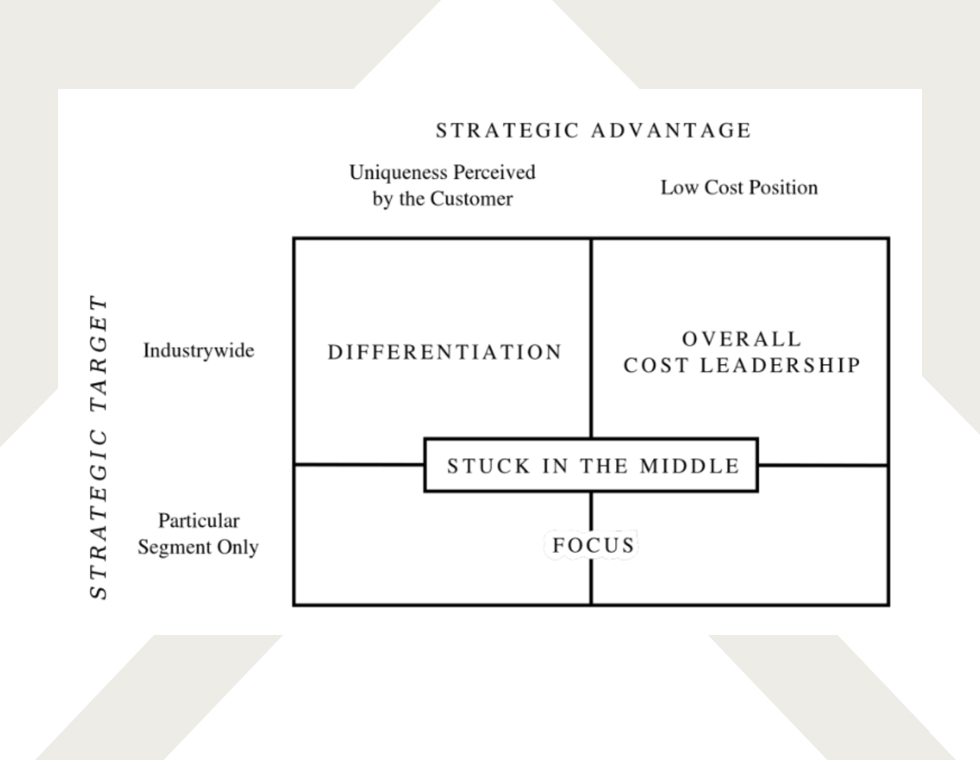
Strategic Frameworks 3 Generic Strategies
Porter’s Generic Strategies describe how a company pursues competitive advantage. There are three paths; either lower cost, differentiated, or focus. The premise of the framework is that a company must choose only one of the three or risk that the business wastes precious resources. The Three Generic Strategies detail the interaction between cost minimization strategies, product differentiation strategies, and market focus strategies.
Description
Every industry has multiple segments that can be targeted by a firm. The breadth of its targeting is referred to as its competitive scope. The firm also has two types of competitive advantage it can pursue: lower cost or differentiation. Achieving competitive advantage requires a firm to make a choice…about the type of competitive advantage it seeks to attain and the scope within which it will attain it. In general:
If a firm is targeting customers in most or all segments of an industry based on offering the lowest price, it is following a cost leadership strategy;
If it targets customers in most or all segments based on attributes other than price (e.g., via higher product quality or service) to command a higher price, it is pursuing a differentiation strategy. It is attempting to differentiate itself along these dimensions favorably relative to its competition. It seeks to minimize costs in areas that do not differentiate it, to remain cost competitive; or
If it is focusing on one or a few segments, it is following a focus strategy. A firm may be attempting to offer a lower cost in that scope (cost focus) or differentiate itself in that scope (differentiation focus).
Cost Leadership
This strategy involves the firm winning market share by appealing to cost-conscious or price-sensitive customers. This is achieved by having the lowest prices in the target market segment, or at least the lowest price to value ratio (price compared to what customers receive). To succeed at offering the lowest price while still achieving profitability and a high return on investment, the firm must be able to operate at a lower cost than its rivals. Firms can become the cost leader by achieving either the highest asset utilization, achieving the lowest cost structure, or by controlling the value chain.
Cost leadership strategies are only viable for large firms with the opportunity to enjoy economies of scale and large production volumes and big market share. Small businesses can be “cost focused” not “cost leaders” if they enjoy any advantages conducive to low costs
Differentiation
A Differentiation Strategy is where the firm changes the products/services in some way in order to compete successfully. A differentiation strategy is appropriate where the target customer segment is not price-sensitive, the market is competitive or saturated, customers have very specific needs which are possibly under-served, and the firm has unique resources and capabilities which enable it to satisfy these needs in ways that are difficult to copy. Differentiation strategy is usually not suitable for small companies. It is more appropriate for big companies.
Focus
This is definitely an appropriate strategy for small companies especially for those wanting to avoid competition with big ones. In adopting a narrow focus, the company ideally focuses on a few target markets (also called a segmentation strategy or niche strategy). These should be distinct groups with specialized needs. It is hoped that by focusing your marketing efforts on one or two narrow market segments and tailoring your marketing mix to these specialized markets, you can better meet the needs of that target market. A focused strategy should target market segments that are less vulnerable to substitutes or where a competitor is weakest to earn above-average return on investment.